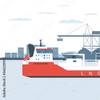On May 15, the Municipal Waterfront Alliance sponsored its second port-wide waterfront conference focused on the legal, environmental, infrastructure, redevelopment, commercial, transportation and economic issues facing the Port of New York & New Jersey. The conference took place in the Hoboken Terminal in New Jersey and the World Financial Center in New York City -- a short water taxi ride for the participants. The conference was attended by approximately 500 people, including 60 federal, state and local government representatives and stakeholders in the future redevelopment of the port complex.
New Jersey Governor James E. McGreevey was the keynote speaker, who described the state's priorities reflected in Executive Orders focused on improving public access to the waterfront; preserving and expanding the maritime economy; and enhancing passenger ferry transportation between the states. Most important, Governor McGreevey highlighted the $29 billion contribution that maritime activities make to the New Jersey economy and the 226,000 jobs generated through direct and indirect maritime commerce. Governor McGreevey also described a constructive and cooperative partnership with New York City and government agencies to ensure that the waterway transportation system is focused on a balanced approach to the development of the bi-states' natural asset -- the "blue highway"-- for the transportation of goods and people.
A segment of the conference dubbed “The Big Blue -- Voices of Waterway Users” included Linda O'Leary, AWO Vice President - Atlantic Region, and Robert Hughes, Hughes Bros. Inc. O'Leary described the vital role the tug and barge industry plays in the everyday operation of the port, including the transportation of bulk commodities such as petroleum products, sand, gravel, coal and municipal solid waste and the crucial services provided by AWO members to the international shipping community in terms of ship assist and harbor services. O'Leary described the challenges and opportunities waterfront redevelopment presents in relation to the tug and barge industry: Design waterfront areas to accommodate the commercial maritime industry and capitalize on the port's asset - the water's edge; preserve the vital role of the marine transportation of people and commodities plays in the daily operations and emergency response situations in the port complex; ensure that new security measures protect commercial vessels through the use of Exclusionary Zones, Safety and Security Zones and Regulated Navigation Areas; and, work diligently with federal, state and local government agencies and the Congressional delegation to ensure that maritime security legislation provides the mechanisms and funding to truly enhance national security and facilitate domestic commerce.
Robert Hughes described his partnership with Reinauer Transportation Company in the development of Erie Basin Bargeport in 1992 and the vital role that facility plays in serving the mooring and berthing needs for the tug and barge industry. Hughes stipulated that the port's pier space is quickly disappearing due to pressure to develop waterfront areas for parks, condominiums and non-water dependent uses. Hughes underscored the need to maintain the existing manufacturing zoning designation for waterfront parcels to allow existing water-dependent uses to continue to economically operate and expand the future. Hughes pointed out that "Everyone loves the ambiance of a nearby tugboat until its fog signals and big diesel engine wakes them at 0300 hours. Our noise generation is within the limits for a manufacturing zone, although we know that there are going to be problems if zoning is relaxed to allow housing next to our facilities. The tug and barge industry is the essence of the term 'water-dependent.' Once our property is taken by government, or zoned out of existence, it is gone forever for our industry! Where are we supposed to go? How can we continue to provide the vital services to the region if there is no tie-up space for our vessels?"
As a solution, Hughes posited that the water dependent users need protective legislation to homeport vessels and protect the areas in which they operate. The tug and barge industry needs the commitment from state and local governments to protect the zoning in the areas vital to the commercial maritime industry. In this vein, the industry will seek the preservation of New York City zoning regulations and amendments to state law, which specifically addresses the preservation of water dependent users.
At the conclusion of the conference, O'Leary was presented with a "Hero of the Harbor" award by Michael Bloomberg, Mayor of the City of New York, on behalf of the crews of the tugboats that played life-saving and evacuation roles on September 11, 2001. O'Leary remarked that "the tug and barge industry was truly New York City's guiding light in our darkest hour, and I have never been prouder of the industry I represent. Nothing was more tragic than seeing the World Trade Center collapse and envisioning the innocent lives lost, and nothing was more inspiring and hopeful than seeing the hundreds of vessels respond to New York City's needs than the plethora of tugs, passenger ferries and every sort of water craft to help and render assistance. The crews aboard those vessels are truly the heroes and heroines." Also receiving awards were Captain Andrew McGovern, (Sandy Hook Pilots), New York and New Jersey passenger ferry operators and the crew of the John Harvey, a decommissioned N.Y.C. fireboat. All vessels and crews played a critical role in responding to the tragic event by exemplifying the very best tradition and virtues inherent in the maritime industry.
Source: AWO Letter
Subscribe for
Maritime Reporter E-News
Maritime Reporter E-News is the maritime industry's largest circulation and most authoritative ENews Service, delivered to your Email five times per week













